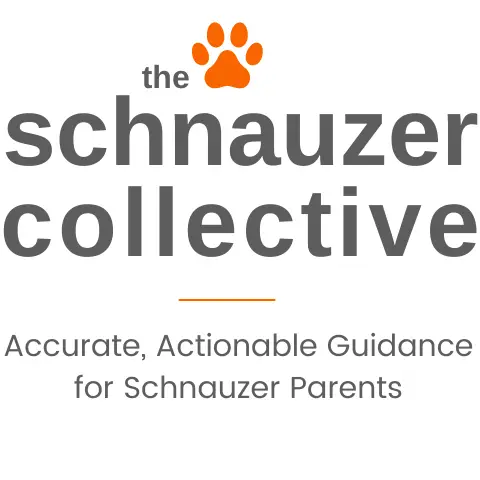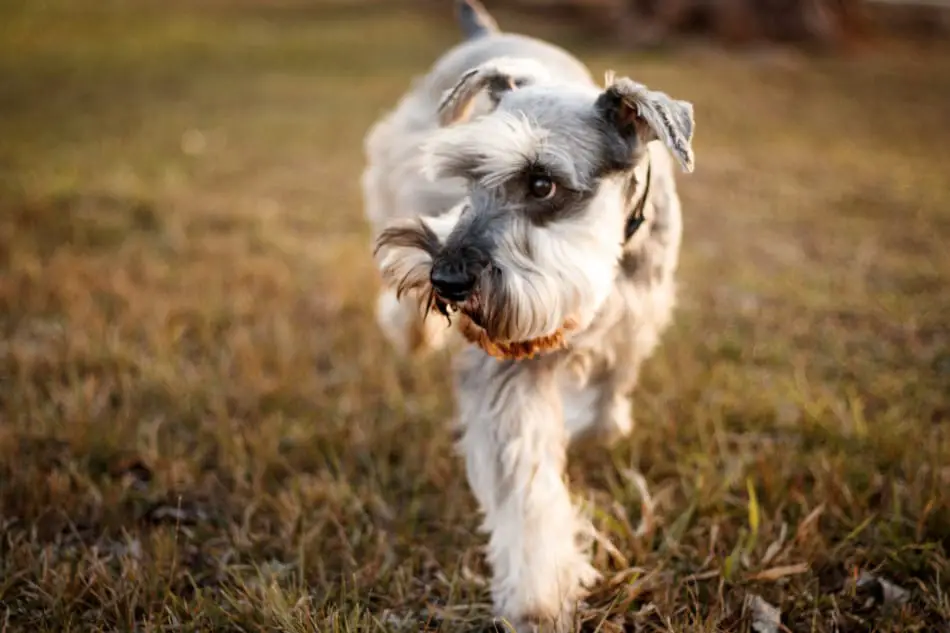With so many dog breed mixes available, the question of whether or not any particular dog is true to its purebred line is a common question. All Schnauzer breeds – Miniature, Standard, and Giant – can be mixed with other breeds to produce such “designer” results as Schnoodles, Schnugs, and Shorkies. You may want to ensure that your Schnauzer is purebred for show purposes, to identify potential genetic health problems, or simply out of interest. There are three ways to know, and we’ll cover them here.
Is my Schnauzer purebred? How to know: Because Schnauzers have such striking physical characteristics, doing a visual inspection of your Schnauzer can sometimes be enough. However, if you want to know for sure, there are 3 primary ways to know:
- Obtain the pedigree from your breeder
- Perform a DNA test
- Consult with your Veterinarian for a thorough check-up
There are several reasons you may want to confirm whether or not your Schnauzer is purebred, and only a few ways to know for sure.
In addition to qualifying as a competitive show dog or knowing more specifically which genetic health issues she might have, you might be interested in the temperament and overall personality of her parents and longer lineage.
In fact, reputable breeders will be able to provide lineage documentation for the prior 3-5 generations.
So, let’s take a look at the three options for confirming your Schnauzer’s pure breed status, and then cover related information such as how to select a reputable breeder.
3 Ways to Know if Your Schnauzer is Purebred
There are really only two highly accurate ways to confirm that your Schnauzer is purebred. The third option, a check-up with your veterinarian, is a solid third option.

#1 Know Her Pedigree
The best way to find out if your Schnauzer is a pure breed is to look at her pedigree. It has a record of the dog’s registered name and the date of birth. A pedigree also documents the history of the Schnauzer’s 3-5 past generations along with the official names of each dam and sire.
Additional titles are also indicated as well as the dog’s color and Orthopedic Foundation for Animals ratings. The document also helps you determine if the dog was a result of:
- Outcrossing: It occurs when there are no common ancestors in the dog’s three to four generations.
- Inbreeding: The method ensures closely related dogs mate, e.g., a father and a daughter, a mother and a son or a brother and a sister.
- Linebreeding: Breeders who use this method ensure the dog’s sire and dam have a common ancestor
The document will also show the dog’s DNA. DNA tests have become incredibly easy and widespread. If it is available, look for an identifying number next to the dog’s name. You also need to check if the pedigree has an official seal.
A reputable breeder should provide a certified pedigree as the information determines the value of the Schnauzer and her eligibility for competition. Thus, a pedigree certified by a recognized kennel association like the American Kennel Club proves that the document is accurate, and should verify her pedigree for at least the prior 3-5 generations.
#2 DNA Testing
If you want to confirm DNA results yourself, there are many reputable kits on the market.
Genetic testing not only helps ascertain the exclusivity of the breed but also diagnose genetic conditions akin to the Schnauzer breed. A DNA test is an examination of the molecular structure of the subject to identify mutations that affect the subject, e.g., a disease, trait or appearance of the dog.
Genetic testing also enables the diagnosis of a disease before it has developed symptoms or before the animal attains the mating stage. As such, breeders can take corrective actions that eliminate disease-causing conditions. The Miniature Schnauzer breed, for example, is known to develop inherited conditions like Myotonia Congenita, Persistent Mullerian Duct Syndrome, and Degenerative Myelopathy.
Here are two great options: One for breed detection and one for breed detection with health screening.
#3 A Comprehensive Veterinary Check-Up
While this third option is less quantifiable than the previous two, a highly trained veterinarian will be able to perform a comprehensive physical examination and determine, with a high degree of confidence, whether or not your Schnauzer is a pure breed.
The Benefits of Knowing if Your Schnauzer is a Pure Breed
I’ve already mentioned a few reasons you may want to know your Schnauzer’s pedigree, but let’s talk about them more in more detail.
To Know if He is Worth the Price
Pure Schnauzers are extremely expensive, with a price range from $600 to $5000.
The high cost is a result of the tests and medical expenses breeders undertake before selling the dogs. Tests like CERF, PRA, and examination of the knees, heart, the hips, teeth, and elbows are costly. Additionally, breeders will have administered the required immunizations before adoption.
The high cost can also be directly related to his pedigree. If you are serious about showing your Schnauzer competitively, you will want a high-caliber pedigree and you will pay a high price to go along with it. Of course, you will want to verify that the pedigree claims are accurate by working with your breeder.
To Compete in Conformation
Dog shows require pet owners to showcase pure breeds only. This is because there are different standards for each dog breed.
For example, the entire Schnauzer breed standard requires the head, chest, neck, tail, and body coat to be plucked. Additionally, the coat should be long enough for the judge to examine its texture.
A specific form of competition that requires a pure bred Schnauzer is Conformation, such as the American Kennel Club’s National Championship. In fact, a Giant Schnauzer earned the Working Dog category’s 1st place ranking in 2019.
To Know the Predictability of Health Challenges
It is easier to predict the potential health problems of a pure Schnauzer breed.
Pure bred Schnauzers, for example, are inclined to develop specific health issues like Persistent Mullerian Duct Syndrome, a mutation that affects male dogs only. The condition causes male dogs to develop external male genitals and internal features of a female Schnauzer.
Another genetic health problem is Myotonia Congenita which prevents Schnauzers, Miniature Schnauzers in particular, from relaxing their muscles normally. This causes them to have an odd stiff or “bunny hopping” walk. They may also have a hard time standing after lying down, and progress with trough swallowing and abnormal barking.
Degenerative Myelopathy is another possibility. It is actually an ancient mutation that afflicts over 100 dog breeds. It has been difficult to eliminate from bloodlines because it does not manifest until a dog is between 7 or 10 years of age. At that late age, the genetic trait has already been passed on through additional breeding. This disease causes an inability to stand or even walk within two years of initial symptoms. There is no cure and physical therapy is the only treatment.
Being aware of these and other potential genetic health problems is a common reason for confirming the purebred nature of a Schnauzer.
“It is easier to predict the potential health problems of a pure Schnauzer breed.”
THE sCHNAUZER COLLECTIVE
Finding a Reputable Schnauzer Breeder
Finding a reputable breeder is critical to ensuring a pure Schnauzer breed.
Good breeders not only act as a bridge between you and a purebred Schnauzer, you should also be able to rely on them for any follow-up throughout your Schnauzer’s life.

Here are some tips for finding a reputable breeder:
Get a Trusted Referral
Your veterinarian, friends, and family may suggest a reputable breeder in your area. You can also contact the local breed club or strike up a conversation with participants at a professional dog show to get referrals for a good breeder.
Visit the American Kennel Club Website
The American Kennel Club is the most reputable site to look for breeders. The organization does not endorse, recommend, or license breeders, but it will help you locate one in your area. The association also has an official website for AKC-registered puppies called AKC Marketplace: PuppyFinder, where you can find a reputable breeder.
You will also want to be familiar with the AKC’s Breeder of Merit Program. Breeders in this program are dedicated to preserving a breed’s original characteristics and siring healthy, energetic pups. As such, you are confident about finding a reputable breeder here.
Ask to Meet the Breeder
Meeting the breeder in person should eliminate any doubts you may have about him. He should explain how long he has been a breeder, whether he is a registered breeder.
Reputable breeders should provide proof of essential health screenings like CERF and OFA certificates. They explain the health conditions affecting Schnauzer dogs, so you know what to watch out for in the future.
The breeder should also provide two or more references from clients he has worked with in the past year. You can visit or call them to find out about their experience with the breeder, how problems were handled, and the pros and cons of working with that breeder.
Reputable breeders are acquainted with two or more dog breeds. It is difficult to develop strong expertise in many breeds. If the breeder is advertising ten or more varieties, it is likely he is not reliable.
You can also review The American Kennel’s Guide to Responsible Dog Breeding.

In addition, here are some questions you will want to ask all breeders you are considering:
13 Questions to Ask a Breeder
- Why do they breed Miniature Schnauzers? It’s good to determine whether they have a true love for the breed or are simply trying to make money on a popular, expensive breed through sub-par breeding practices.
- Do they belong to a breed club? Ask for references and confirmation that they belong to, and participate in, the club.
- How long have they been breeding Schnauzers? This will give you a sense of their experience and knowledge.
- Can they provide recommendations? Ask the breeder for three or four references from Schnauzer owners who have purchased from them within the past year. When you call, ensure that each reference had a good experience, found the breeder to be trustworthy, and that their Schnauzer is healthy.
- Do they require a limited registration? Do they require that you spay or neuter your dog by a specific age? A limited registration is for Schnauzer puppies that the breeder does not want to be part of a continued breeding program. Sometimes, this is because the specific Schnauzer does not meet their breeding criteria and they want to protect the quality of their breeding program. This American Kennel Club article is a good source for more information.
- Do they provide a health certificate and certificate of sale. Does the breeder offer a health certificate that is issued by a veterinarian? Your state may also require a certificate of sale. Ask the breeder if he will supply a health certificate for the puppy issued by his veterinarian. Some states require also a certificate of sale or certification of veterinary inspection. The American Veterinary Medical Association lists states the need this documentation.
- How many litters of Schnauzers did they have last year? There are responsible limits to breeding and how many litters a dam should have each year. Responsible limits are between 1 and 3, but many high-caliber breeders only permit their dams to have one litter per year.
- What makes their dam & sire good choices for breeding Miniature Schnauzers? The breeder should know the genetic qualities that the dam and sire bring to the breeding process.
- Are the dam and sire on site for you to meet? If you have an opportunity to interact with the Schnauzer’s parents, it can give you a firsthand idea as to what you may expect with the Schnauzer you are considering purchasing. You’ll be able to see their temperament and physical health.
- What is the breeder currently feeding the Schnauzer? You will want to continue feeding your Schnauzer puppy the same food for at least the first few days. This decreases any risk of gastrointestinal problems. You should visit with a veterinarian within the first several days of bringing the puppy home, at which time you could talk with the vet about changing the type of diet you feed.
- What vaccinations, de-worming, or other interventions have been administered? Most breeders will administer a Schnauzer’s first round of vaccinations and de-worming or heartworm medications, if needed. This information will be essential since you will need to know how to proceed with a schedule.
- Have the Schnauzers been trained or socialized? Many breeders will potty train the litter and also being socializing them somewhat before they leave. Knowing this information will prepare you for what additional training your Schnauzer may need. Keep in mind that initial training of any kind is just a beginning. All Schnauzers will benefit from obedience training and a lot of socialization.
- Have any of the puppies been sick or injured? Be sure that you know if there have been any problems with any of the puppies. Dogs can pass illnesses among themselves and injuries can either signal a lack of attention and responsibility, or genetic problems within the litter.
A Review of the Three Schnauzer Breeds
As a final note, it might be worth reviewing each of the three Schnauzer breeds.
A breeder may specialize in one or more Schnauzer breed, with Miniature Schnauzers currently being the most popular.
Standard Schnauzer


- Height: 17-20 inches
- Weight: 35-45 pounds
- Lifespan: 12-16 years
- Food: 1-2 cups each day, spread over two meals
- Intelligence: Ranked in the top 22 of 140 dogs
- Popularity: Ranked 90th out of 190 dogs
Standard Schnauzer: This is the original Schnauzer breed and is also known as Mittelschnauzer. Standard Schnauzers are classified as working dogs primarily bred to catch rats, guard livestock, and carry messages during WWII. It has common ancestry with the German Pinscher and is believed to be a cross of the gray Wolf Spitz and the black German Poodle. It explains why the Standard Schnauzer comes in two colors: the soft black coat and the salt, peppery gray wiry coat.
Giant Schnauzer


- Height: 23-28 inches
- Weight: 65-110 pounds
- Lifespan: 10-12 years
- Food: 4-5 cups each day, spread over two or more small meals
- Intelligence: Ranked in the top 35 of 140 dogs
- Popularity: Ranked 80th out of 190 dogs
Giant Schnauzer: This is by far the largest of the three breeds. Giant Schnauzers are native to southwest Germany and were primarily bred to guard farms and drive livestock to the market. Later they were used as military and police dogs. The dog is believed to be a cross of the black Great Danes, German Shepherds, Munchener, Boxers, Rottweilers, Thuringian Shepherds, Dobermans, and the Standard Schnauzer.
Miniature Schnauzer


- Height: 10-24 inches
- Weight: 10-20 pounds
- Lifespan: 10-16 years
- Food: 3/4 – 1 cup each day, spread over two meals
- Intelligence: Ranked in the top 12 of 140 dogs
- Popularity: Ranked 18th out of 190 dogs
Miniature Schnauzer: This is the smallest and most recent Schnauzer breed. They were developed in the 19th century as a crossbreed between the original Standard Schnauzer with the Miniature Poodle or the Affenpinscher. Miniature Schnauzers were bred as vermin hunters, but today they make excellent guard dogs despite their small body construction. They come in three standard colors: black and silver, pepper/salt, and black. There are also many recent “designer” colors due to variations in breeding. The “teacup” size is also relatively recent and is still considered to be a Miniature Schnauzer. While teacup sizes are gaining popularity, there is some concern for health issues and the AKC does not officially recognize the sizes as a separate breed or for competition purposes.
And finally, from one pet parent to another, discover my all-time favorite resources designed to cover your every Schnauzer need. I’ve done the legwork for you so you can spend more time with the people and fur friends in your life.
A portion of all profit earned on this site is donated to Pet Partners
whose mission is to improve human health and
well-being through the human-animal bond.
They train and register pets to become therapy animals,
and have local chapters in many states.

